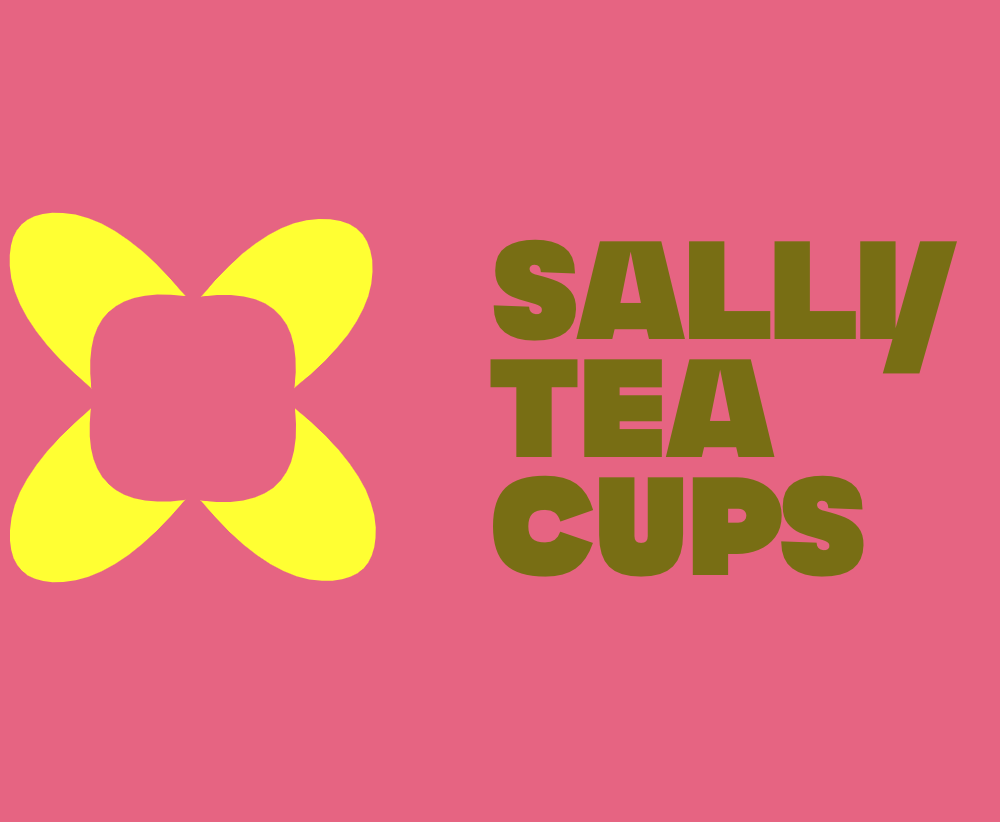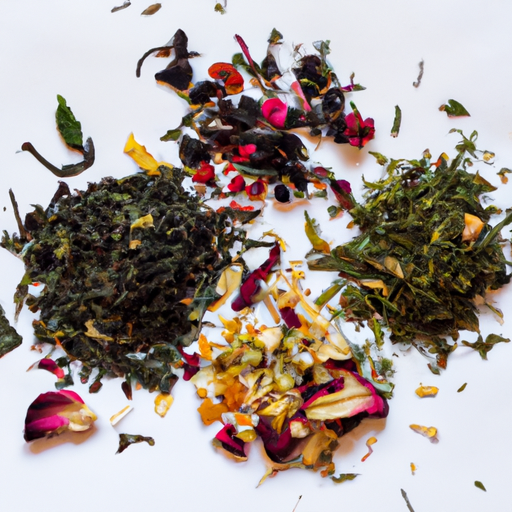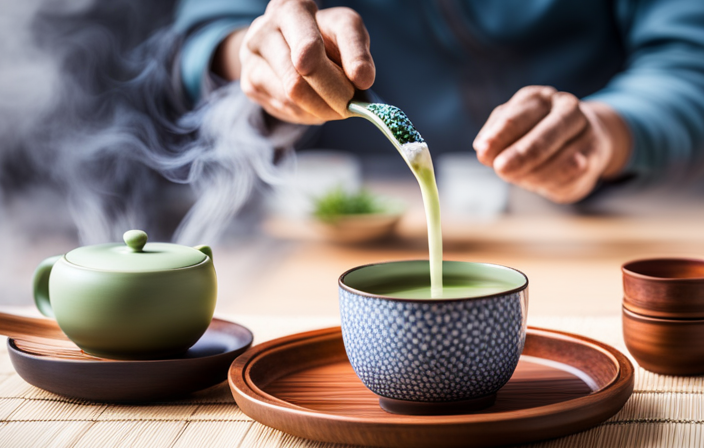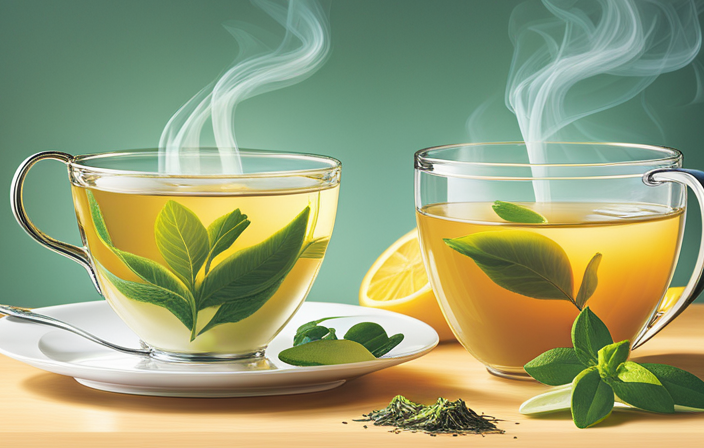Tea Brewing and Preparation
Natural Ways To Reduce Stress And Relieve Anxiety With Tea

Feeling overwhelmed by the demands of daily life can be like trying to swim against a powerful current. The waves of stress and anxiety can threaten to pull us under, leaving us gasping for air.
But what if I told you there was a way to ride those waves with ease, to find a sense of calm and relaxation amidst the chaos? Enter tea, the gentle life raft that can help us navigate the turbulent waters of our minds.
Tea, with its soothing warmth and comforting aroma, has long been cherished as a remedy for stress and anxiety. But its healing powers go beyond mere tradition. Science has shown that tea has the ability to activate alpha brain waves, those magical frequencies associated with relaxation and tranquility.
By sipping on a cup of tea, we can tap into our body’s natural mechanisms for reducing stress and promoting a sense of well-being.
In this article, we will explore the benefits of alpha brain waves, delve into the connection between tea and these calming frequencies, and discover how tea can be a valuable tool in our quest to find inner peace.
So grab your favorite mug, settle into a cozy spot, and let’s embark on a journey to unlock the secrets of natural stress reduction with tea.
Key Takeaways
- Activating alpha brain waves can help reduce stress and relieve anxiety.
- Tea containing the amino acid l-theanine can increase alpha brain waves and induce a calm and relaxed state.
- Spending time in nature and engaging in stress-reducing activities can increase alpha brain waves and lower stress levels.
- Pet therapy, such as interacting with pets, can reduce stress and improve mental and physical health.
What is it?
Tea is a natural remedy that I can use to reduce stress and relieve anxiety. There are different types of tea that have positive effects on stress reduction. For example, black tea contains compounds that can help reduce the production of stress hormones in the body, while green tea contains an amino acid called l-theanine that’s been shown to increase alpha brain waves, inducing a calm and relaxed state.
Incorporating tea drinking into a daily self-care routine can be a great way to reduce stress naturally. Taking a few minutes each day to prepare and savor a cup of tea can provide a moment of mindfulness and relaxation. It’s important to choose a tea that you enjoy and to make the tea-drinking experience a soothing and calming one.
Benefits of Alpha Brain Waves
Listening to my favorite playlist is like taking a refreshing dip in a calm and peaceful ocean, as it activates my alpha brain waves and helps me experience a state of deep relaxation. Alpha brain waves have numerous benefits when it comes to reducing stress and relieving anxiety.
Here are three ways in which meditation and alpha brain waves can benefit our overall well-being:
-
Improved focus and concentration: Alpha waves are associated with a relaxed but alert mental state. By increasing alpha brain wave activity through meditation, we can enhance our ability to concentrate and stay focused on the present moment.
-
Reduced anxiety and stress: Alpha brain waves have been found to counteract the effects of stress hormones, promoting a sense of calm and relaxation. Regular meditation practice can help regulate stress responses and reduce anxiety levels.
-
Enhanced creativity and problem-solving: Alpha waves have been linked to increased creativity and enhanced problem-solving abilities. By accessing these brain waves through meditation, we can tap into our creative potential and find innovative solutions to challenges we may face.
Incorporating meditation into our daily routine can have profound effects on our mental and emotional well-being, thanks to the benefits of alpha brain waves.
Tea and Alpha Brain Waves
When I engage in activities that increase alpha brain waves, such as meditation or spending time in nature, I feel a sense of calm and relaxation. It’s fascinating how certain activities can have such a profound impact on our mental state. One activity that I have found particularly effective in promoting relaxation and reducing stress is drinking tea. Tea, especially varieties that contain the amino acid l-theanine, has been shown to increase alpha brain waves, which are associated with a relaxed mental state. This relationship between tea and alpha brain waves is believed to be one of the reasons why tea has a calming effect on the mind.
To give you a better idea of the different types of tea and their effects on cognitive function, here is a table:
| Tea Type | Benefits |
|---|---|
| Green Tea | Enhances brain function and improves focus |
| Black Tea | Reduces stress and promotes relaxation |
| Oolong Tea | Boosts mental alertness and improves cognitive function |
By incorporating tea into my daily routine, I have noticed a significant improvement in my ability to relax and manage stress. It’s amazing how something as simple as a cup of tea can have such a positive impact on our well-being. So, the next time you’re feeling stressed or anxious, why not try sipping on a soothing cup of tea and see how it affects your alpha brain waves and overall state of relaxation.
Tea as a Stress-Reducing Activity
By engaging in stress-reducing activities like spending time in nature or practicing meditation, I’ve noticed a significant improvement in my ability to relax and manage my stress levels.
Another activity that’s become a crucial part of my stress reduction routine is indulging in tea rituals and mindfulness. Exploring different types of tea blends hasn’t only introduced me to new flavors but has also allowed me to embrace the calming and therapeutic aspects of tea.
The process of preparing and savoring a cup of tea encourages me to slow down, be present, and focus on the moment. Whether it’s the earthy notes of black tea or the delicate aroma of green tea, each blend offers a unique experience that helps me find solace and tranquility.
Incorporating tea into my daily routine has become an essential tool in my journey to reduce stress naturally and achieve a sense of well-being.
Frequently Asked Questions
Can drinking tea with l-theanine help with conditions other than stress and anxiety?
Drinking tea with l-theanine has the potential to impact mood disorders beyond stress and anxiety. Exploring the possibilities, research suggests that l-theanine may have a positive effect on mood regulation, promoting feelings of calmness and relaxation.
How long does it take for tea to induce a calm and relaxed state?
Drinking tea can induce a calm and relaxed state within 30 minutes. It has been shown to improve sleep quality and enhance cognitive function, thanks to the presence of l-theanine and other beneficial compounds.
Are there any potential side effects of consuming tea with l-theanine?
There are no known major side effects of consuming tea with l-theanine. It is generally considered safe. However, it’s important to choose the right dosage of l-theanine in tea to avoid any potential adverse reactions.
Can drinking tea with l-theanine be a substitute for medication in treating anxiety?
Drinking tea with l-theanine can be a beneficial supplement to medication in treating anxiety. Studies have shown that l-theanine promotes relaxation and increases alpha brain waves, providing a natural and calming effect.
Are there any specific types of tea that are more effective in increasing alpha brain waves and reducing stress?
Different types of tea, such as black, green, and oolong, can be effective in increasing alpha brain waves and reducing stress. The impact of tea on overall cognitive function includes promoting relaxation and inducing a calm state.
Conclusion
In conclusion, incorporating tea into my daily routine has proven to be a remarkable strategy for alleviating stress and anxiety. The activation of alpha brain waves through the consumption of tea, specifically those containing l-theanine, has a profound impact on inducing a state of tranquility and calmness.
By engaging in this slow and mindful process, I’ve discovered a natural and effective means of promoting well-being and reducing the burdens of everyday life. Embracing the gentle art of tea drinking has truly become a cherished ritual in my pursuit of inner peace.
Tea Serving Etiquette
Tea Etiquette Around the World: What’s Different and Why
How do tea traditions reflect cultural values across the globe? Discover the intriguing differences that make each tea ritual unique and meaningful.
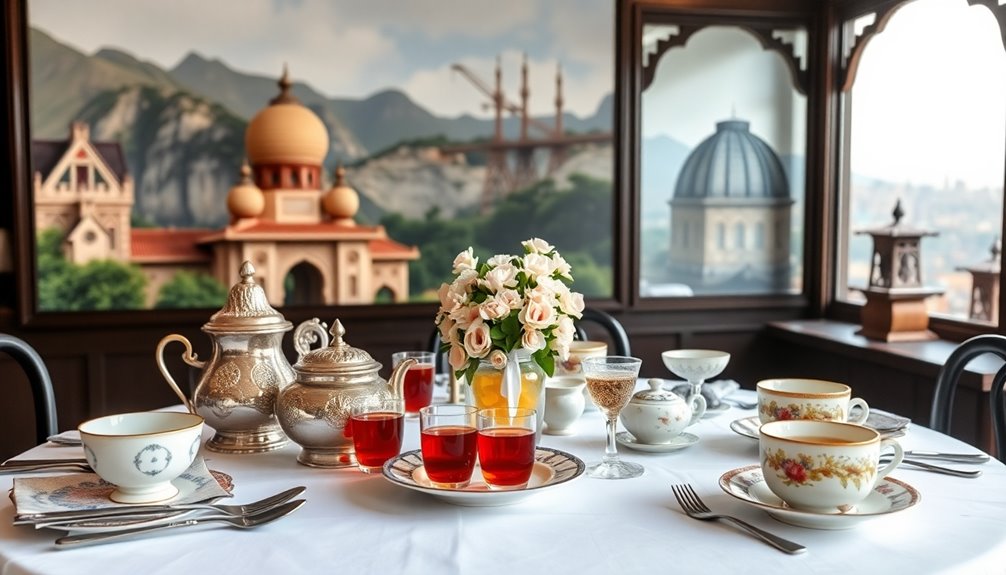
Tea etiquette varies greatly around the world, with each culture holding unique customs that reflect their values. In Japan, the precision of the tea ceremony promotes mindfulness, while in Kenya, sharing a cup strengthens community bonds. Turkish tea is served strong and sweet in small glasses, emphasizing hospitality. Argentine mate is enjoyed through a communal ritual, showcasing camaraderie. Each variation highlights respect and connection in social settings. Understanding these differences can deepen your appreciation of tea culture globally, and you'll discover even more fascinating practices that define tea traditions in various regions.
Key Takeaways
- Japanese tea ceremonies prioritize mindfulness and respect, emphasizing precise gestures and aesthetics in their rituals.
- Turkish tea is traditionally served strong and sweetened in small glasses, symbolizing warmth and hospitality.
- In Argentina, mate is shared communally without stirring, highlighting respect and camaraderie among participants.
- Kenyan tea practices involve sharing and refills, reinforcing community bonds and making refusal impolite.
- Cultural appropriation of tea customs risks diluting their significance, emphasizing the need for respect and understanding of origins.
Introduction
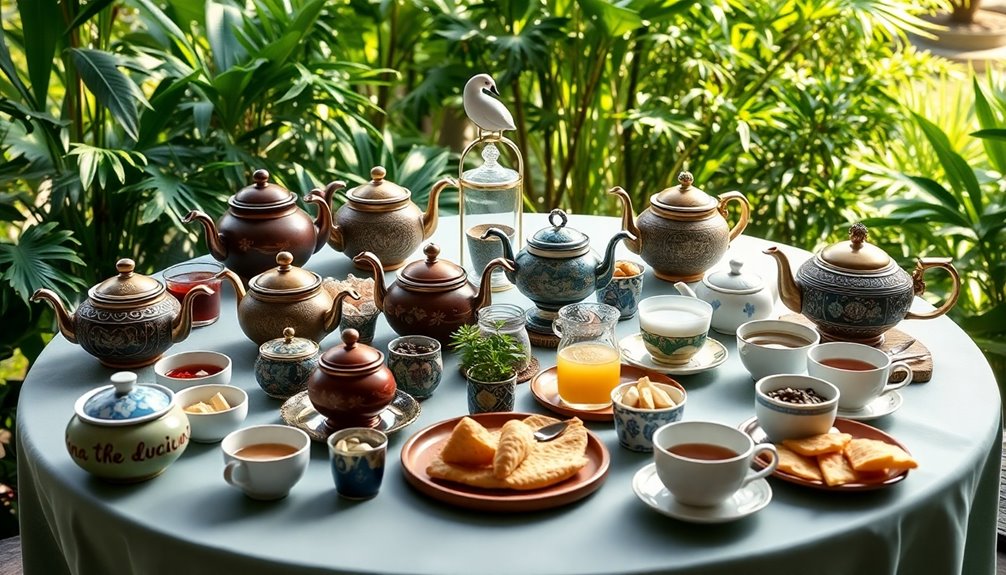
Tea is more than just a beverage; it's a cultural ritual that varies widely around the globe. When you dive into the world of tea, you'll discover rich traditions and unique tea etiquette that reflect local customs and values surrounding hospitality.
For instance, in Japan, the tea ceremony highlights respect and aesthetics; you should hold your cup with two hands and feel free to slurp the tea as a way to appreciate its flavor.
In contrast, if you find yourself in Turkey, you'll notice black tea served in small, curved glasses, typically accompanied by sugar but no milk—an important cultural custom.
When you visit India, expect to politely decline the first offer of chai, as accepting it upon insistence shows respect for your host's hospitality.
Meanwhile, in Russia, tea is often part of social gatherings, and serving it without snacks can be considered rude, emphasizing the importance of pairing food and drink.
Each of these examples illustrates how drinking tea transcends mere consumption; it's an experience shaped by a tapestry of traditions and cultural nuances.
Global Tea-Serving Customs

Experiencing tea around the world means encountering a variety of serving customs that reflect each culture's values and social norms.
For instance, in Hong Kong, you won't pour your own tea—your host will serve you, and tapping your fingers on the table shows gratitude. In Turkey, tea is served in small, curved glasses, brewed strong and sweetened, symbolizing hospitality.
Meanwhile, Argentine tea drinkers cherish mate, passing the gourd around without stirring it, as accepting the mate signifies respect within the group. Traditional Japanese tea ceremonies highlight the importance of mindfulness; you'll hold your cup with both hands and appreciate the tea quietly, with slurping allowed to enhance the experience.
In Kenya, sharing tea is essential for building community, and guests are expected to accept offered cups, as refusal can be seen as impolite.
You'll also find various tea traditions from around the globe, including the love for black tea in India, where it's often brewed with spices and served in bustling street stalls.
Each of these customs showcases the unique way different cultures value connection and hospitality through tea.
Cultural Tea Serving Variations

Many cultures have unique ways of serving tea that reflect their values and traditions. In Turkey, for example, black tea is served in small, curved glasses, often sweetened with sugar to enhance the strong flavor. Milk or cream is typically avoided, showcasing a preference for traditional, unadulterated tea.
Meanwhile, in Japan, the tea ceremony (Chanoyu) emphasizes aesthetics and respect. Here, preparing and serving matcha involves precise gestures that highlight harmony and mindfulness.
In Morocco, Moroccan Mint tea is heavily sweetened and poured from a height to create a frothy top, symbolizing hospitality and social connection. This ritualized process is central to their tea drinking culture.
Argentine mate rituals take a different approach—participants pass the mate gourd around, sharing without stirring the leaves, which promotes camaraderie and respect.
In Kenya, tea is often accompanied by local snacks, and it's customary to accept offered cups, with refills expected if the cup is less than half full.
These cultural tea serving variations show how tea is more than just a beverage; it's a reflection of community, tradition, and connection across the globe. Additionally, the calming effects of certain essential oils, such as lavender oil, can enhance the overall experience of tea drinking by promoting relaxation and mindfulness.
Ceremonial Tea Serving Rituals
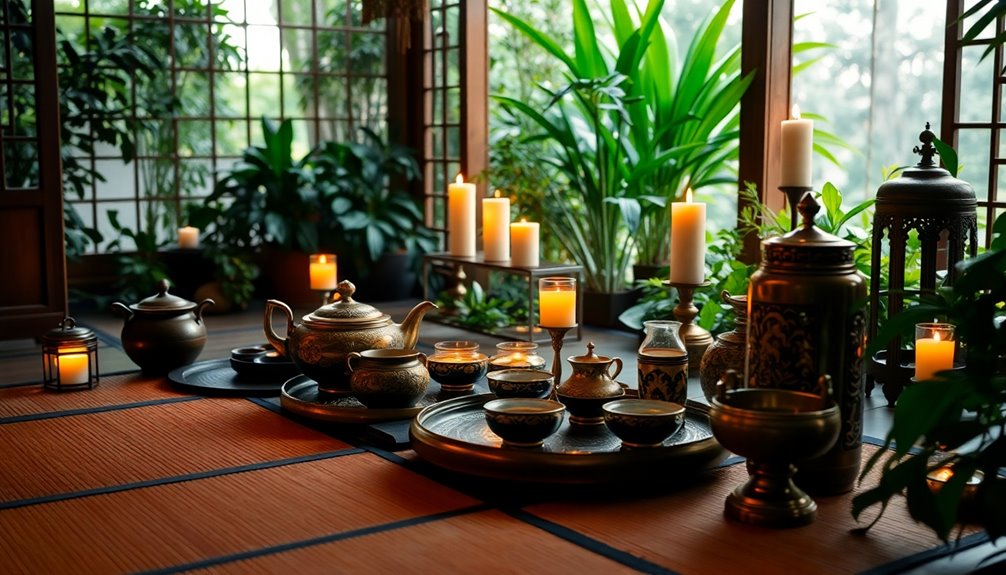
Focusing on the art of ceremonial tea serving reveals a rich tapestry of rituals that vary widely across cultures.
In Japan, the tea ceremony, or Chanoyu, invites you to experience harmony and mindfulness as you prepare and serve matcha in a serene setting. Each movement is deliberate, promoting tranquility and reflection.
In contrast, the Chinese Gongfu tea ceremony showcases skillful brewing with structured steps, allowing you to appreciate the tea's nuances while fostering a deep connection to the beverage.
Meanwhile, in Morocco, the act of pouring tea from a height creates a frothy top, symbolizing hospitality and enhancing your overall tea experience.
When you partake in Indian Masala Chai customs, you'll find that refusing the first offer is polite; accepting it later signifies respect and reinforces hospitality.
In Turkey, tea served in small, curved glasses promotes sharing in social settings, strengthening community connection among friends.
Each of these rituals not only enriches the tea experience but also cultivates mindfulness, reminding us of the importance of connection and respect in every cup.
Cultural Appropriation of Tea Practices
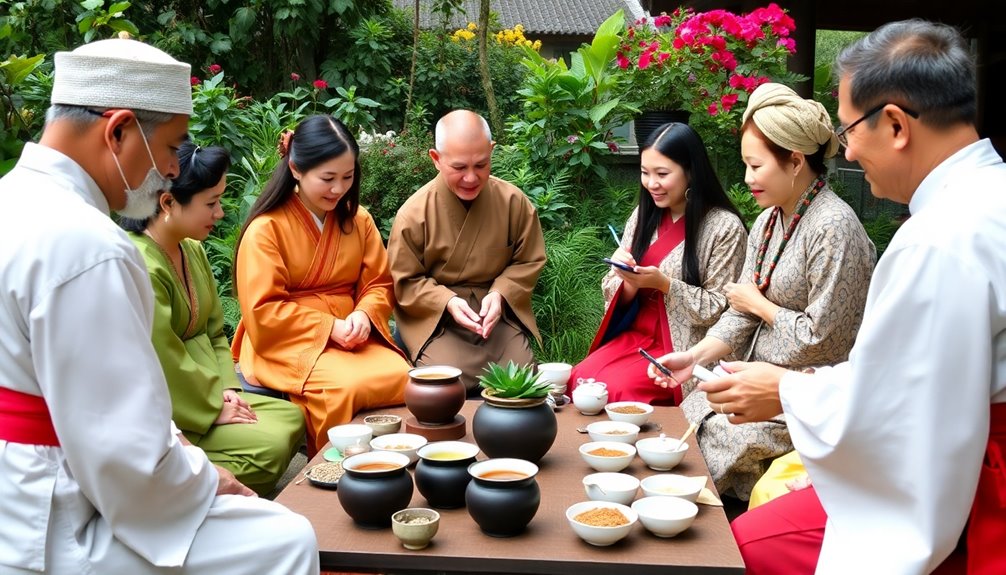
While exploring the rich rituals surrounding tea, it's important to consider how these traditions can be misrepresented through cultural appropriation. When you adopt elements of traditional tea practices, like the Japanese tea culture's Chado, without understanding their historical and cultural significance, you risk diluting their essence. This practice emphasizes spirituality and mindfulness, which are often overlooked in adaptations.
Similarly, Western iterations such as afternoon tea can strip away the depth and nuances of British tea customs, turning a revered tradition into just another social event. In India, the commercialization of chai leads to variations that disregard essential preparation methods and the communal significance that defines its identity.
To truly engage with tea practices, it's crucial to respect and honor their origins. Recognizing the values, rituals, and community significance tied to these traditions fosters a deeper appreciation.
Instead of appropriating, consider promoting cultural exchange that enriches your understanding. By doing so, you contribute to a more respectful dialogue around tea, ensuring that the art of making and sharing tea remains a celebration of its rich heritage rather than a mere trend.
Practical Applications
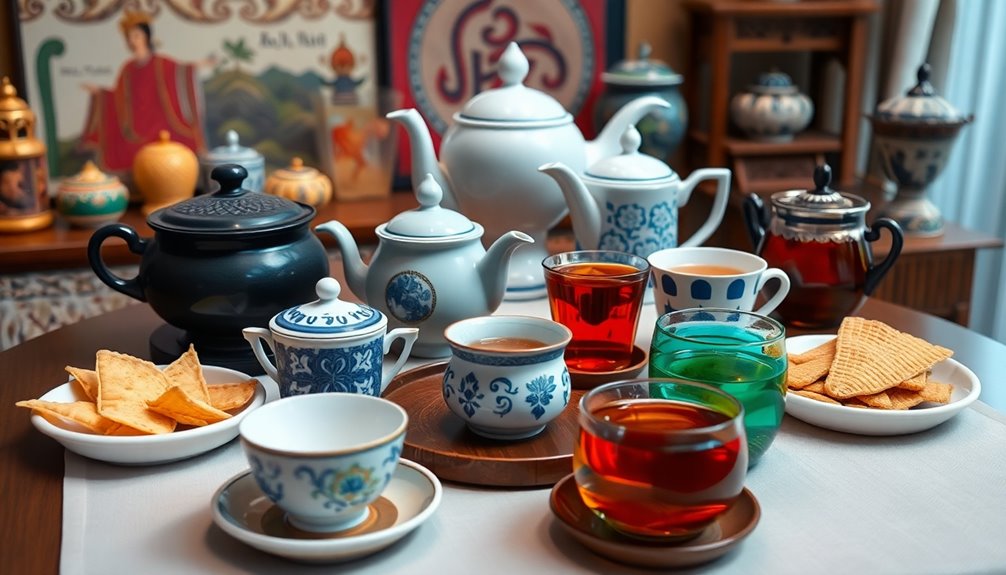
Navigating tea etiquette across cultures can enhance your experience and show respect for local traditions. When you find yourself in a Japanese setting, remember to bow slightly when receiving tea; this gesture embodies respect.
Participate in the tea ceremony by holding your cup with both hands, appreciating the tea's cultural significance and the mindfulness it encourages.
In Turkish culture, you'll encounter black tea served in small, curved glasses. Feel free to add sugar, but avoid milk to maintain the traditional taste.
If you're in China, accepting tea is crucial; refusing it could be seen as disrespectful. Always offer and accept tea with both hands to honor the customs.
In Kenya, tea is a communal experience. Even if you only sip from your cup, accepting the offer fosters community and connection.
Each culture features various types of tea and unique traditions that enrich your understanding and appreciation of this beloved beverage.
By embracing these practices, you'll not only enjoy your tea but also strengthen your social interactions and deepen your cultural knowledge.
Conclusion
In exploring tea etiquette around the world, you've discovered diverse customs that reflect each culture's values and traditions. From Japan's meticulous tea ceremonies to the casual afternoon tea in England, each practice adds richness to the global tapestry of tea. By understanding and respecting these variations, you can appreciate the deeper meanings behind each cup. So, next time you enjoy tea, remember the unique stories and customs that shape this beloved beverage across the globe.
Tea Serving Etiquette
How to Impress Guests With Flawless Tea Etiquette
Craft the perfect tea gathering with essential etiquette tips that will leave your guests in awe—discover the secrets to flawless hosting!
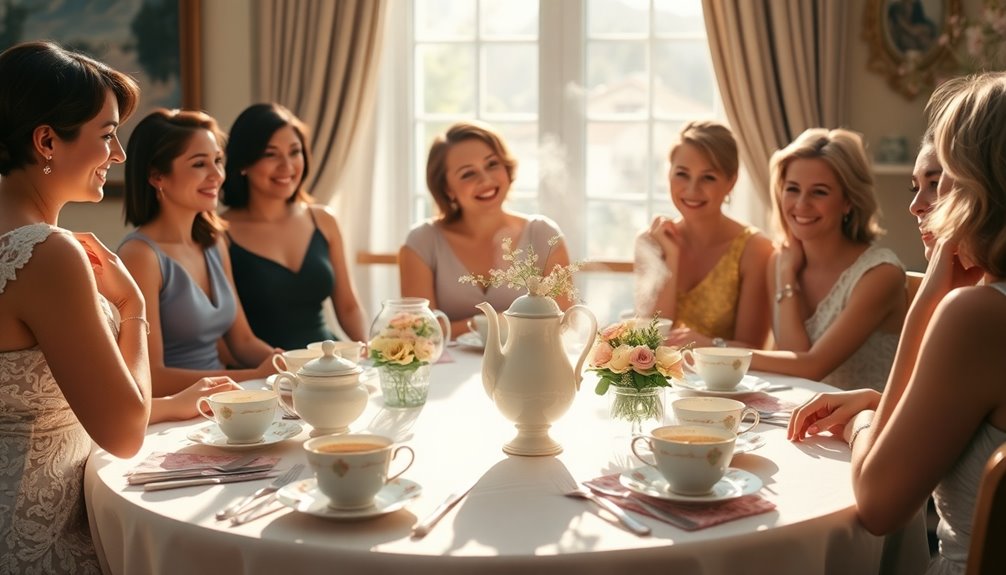
To impress your guests with flawless tea etiquette, focus on key elements. Start with a proper three-tiered stand: finger sandwiches on the bottom, scones in the middle, and sweets on top. Remember to pour tea for your guests, filling their cups three-quarters full. For scones, never cut them with a knife—break them by hand to preserve their texture. Also, get the pronunciation right; it's crucial for showing respect. Dress smartly, and don't forget to provide clotted cream and jam. Mastering these details makes your gathering memorable, and there's so much more that can elevate your tea experience!
Key Takeaways
- Understand the distinction between afternoon tea and high tea to set the right expectations for your gathering.
- Adhere to the dress code, opting for smart casual or business casual attire to create a polished atmosphere.
- Serve the food in the correct order: start with finger sandwiches, followed by scones, and finish with sweets.
- Use proper scone etiquette by breaking them by hand and spreading toppings with a knife to enhance the experience.
- Be mindful of tea pouring techniques, filling cups three-quarters full and using a strainer for an elegant presentation.
Introduction
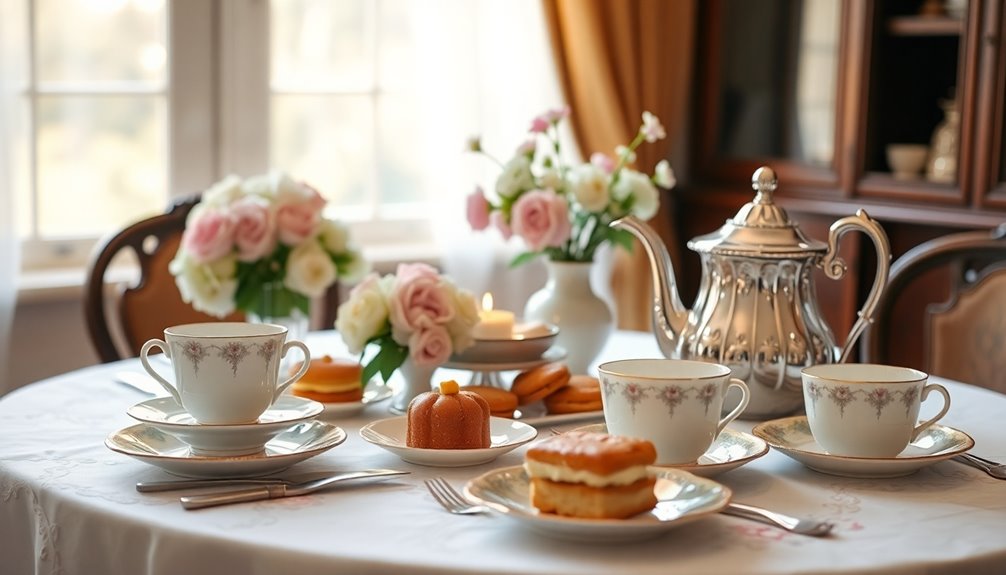
When hosting a tea gathering, mastering the nuances of tea etiquette can transform a simple event into an elegant experience. Understanding the distinction between afternoon tea and high tea is essential for setting the right expectations.
Dressing according to the dress code—smart casual or business casual—shows respect for this British tradition and helps impress your guests.
Good manners play a crucial role in creating a warm atmosphere. Familiarize yourself with proper napkin usage; placing it on your lap and using it to dab your mouth reflects your attention to detail.
To enhance your experience, follow the order of eating: start with finger sandwiches, then savor scones, and finish with sweets. This sequence not only showcases your understanding of tea etiquette rules but also elevates the flavor of each item.
British Afternoon Tea Origins
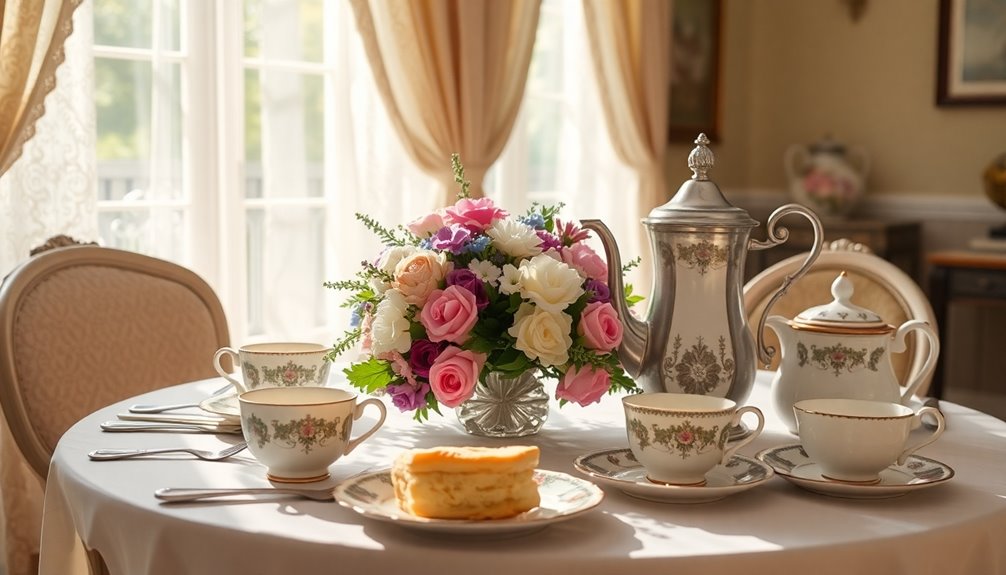
Originating in the early 19th century, afternoon tea emerged as a delightful solution to the long stretch between lunch and dinner. It was introduced by Anna, the Duchess of Bedford, who found herself famished during the gap. This practice quickly became a fashionable social event among the upper class, solidifying its place in British culture.
During the Victorian era, afternoon tea evolved into an elaborate tea party, often featuring a delightful assortment of finger sandwiches, delectable pastries, and, of course, scones served with clotted cream and jam.
Typically enjoyed between 3 PM and 5 PM, 4 PM became the ideal time for this leisurely social gathering, allowing friends and family to connect over tea and treats.
It's essential to note the distinction between afternoon tea and high tea. While afternoon tea offers a light meal in the afternoon, high tea is a more substantial evening meal, associated primarily with the working class.
Understanding these nuances will help you appreciate the rich history of afternoon tea and its significance in British culture, ensuring you impress your guests with your knowledge and etiquette at your next tea party. Additionally, the practice of sharing tea fosters emotional resilience, as it provides a comforting space for connection and support among friends.
Scones Should Not Be Cut
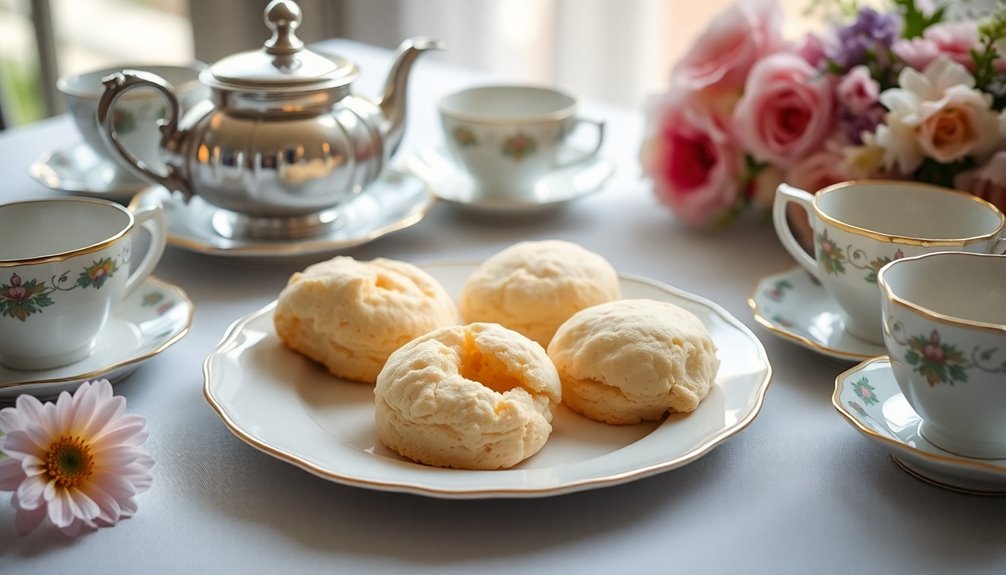
Understanding the nuances of afternoon tea extends beyond just the timing and treats; it also encompasses the proper way to enjoy each item, particularly scones.
When it comes to this traditional treat, etiquette dictates that you should never cut them with a knife. Instead, break scones by hand into bite-sized pieces. This method preserves their delicate texture and integrity, ensuring you get the full experience.
Cutting a scone can lead to a dry, crumbly texture, detracting from your enjoyment. The proper way to enjoy a scone involves separating the top from the bottom, using a knife solely for spreading jam and cream.
Scone Pronunciation Impacts Perception
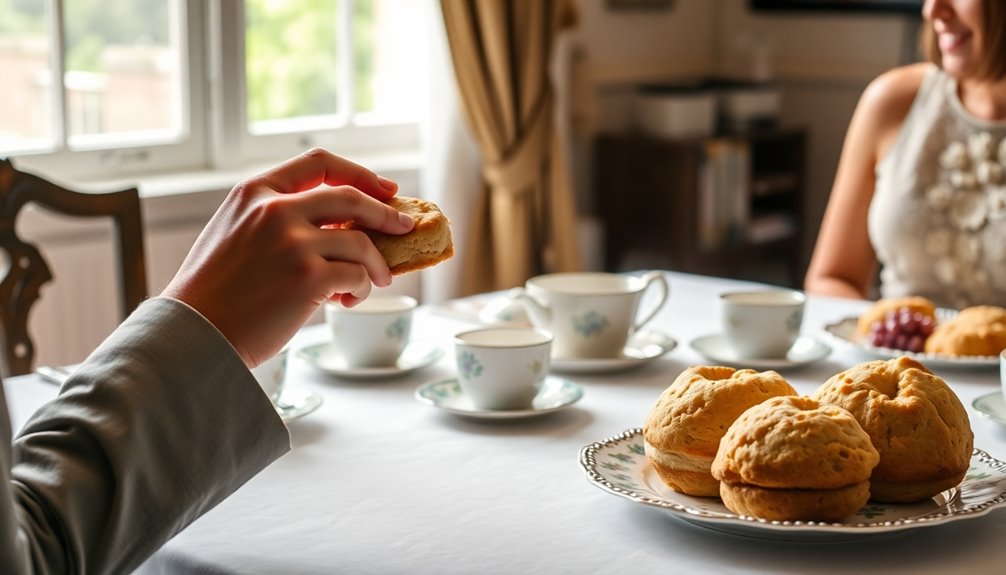
The way you pronounce "scone" can significantly shape how others perceive your grasp of tea etiquette. In social settings, the distinction between saying "scone" as it rhymes with "gone" or "cone" often reflects cultural differences in British tea traditions. Mispronouncing it might lead to misunderstandings, potentially diminishing the sophistication of your afternoon tea experience.
Using the correct pronunciation demonstrates your familiarity and respect for British tea culture, enhancing your credibility among guests. Proper pronunciation signals attention to detail, which is vital in formal tea environments. When you articulate "scone" correctly, you elevate the overall ambiance and show that you've invested time in understanding regional customs.
Awareness of local pronunciation preferences can also foster better connections with your guests, making them feel appreciated and understood. This sensitivity to cultural nuances is essential for creating an inviting atmosphere at your gathering. Additionally, understanding cultural influences on dining etiquette can further enhance your hosting skills and the overall experience for your guests.
Scone Toppings Spark Debates
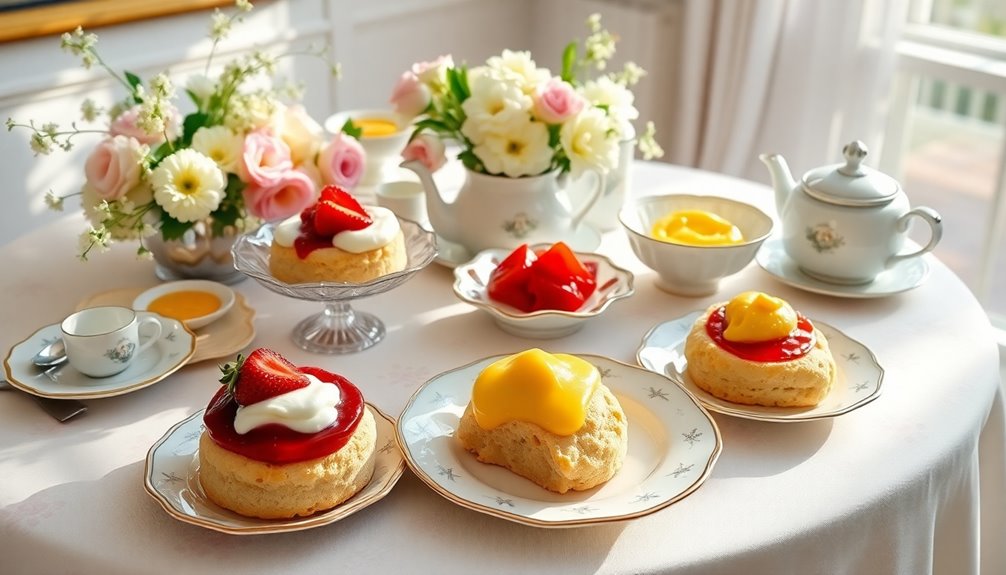
When it comes to scone toppings, debates can spark lively conversations among tea enthusiasts. The two main methods—Devon and Cornish—create a divide: Devon spreads clotted cream first, while Cornish puts jam on first. This ongoing debate not only reveals personal preference but also enriches the social atmosphere of your afternoon tea.
Proper etiquette dictates that you should break scones by hand rather than cutting them with a knife. Additionally, it's best to spread toppings on individual pieces instead of reassembling the scone after applying the spreads. Make sure to provide both clotted cream and jam to cater to your guests' varying tastes, showing respect for traditional customs.
You might find that discussions about whether to serve cold or hot milk with tea parallel the scone topping debates. Each choice reflects individual taste and can lead to engaging conversation.
Practical Applications

At an afternoon tea, practical applications of etiquette can elevate the experience for both hosts and guests. Start by ensuring everyone adheres to the dress code—women in dresses or slacks and men in trousers and collared shirts. This sets a respectful tone for the gathering.
When organizing your three-tiered stand, place sandwiches first on the bottom tier, followed by scones in the middle, and sweets on the top. This arrangement enhances presentation and flow during the tea service. Consider using essential oils to create a calming atmosphere that complements the elegant setting. Additionally, ensure that your venue has adequate HVAC systems to maintain a comfortable temperature throughout the gathering.
As the host, make it a point to pour tea for your guests. Fill their cups three-quarters full and use a strainer for loose leaf tea to maintain order. Providing a HEPA filter technology air purifier can significantly improve air quality, creating a more pleasant environment for your guests.
Serve scones by breaking them into pieces instead of cutting them, and don't forget the clotted cream and jam; let guests spread according to their preference. Additionally, consider providing an air purifier to enhance the ambiance by ensuring clean air during the gathering. Regular maintenance of your air purification system ensures optimal performance, contributing to a more enjoyable atmosphere.
Conclusion
By mastering these tea etiquette tips, you'll elevate your hosting skills and impress your guests. Remember the rich history of British afternoon tea, embrace the correct scone pronunciation, and navigate the toppings debate with confidence. When you serve scones whole and guide your guests through each aspect of the experience, you'll create a memorable atmosphere that celebrates the tradition of tea. So, put on your best smile, and enjoy the delightful moments you'll share!
Tea Serving Etiquette
What Your Tea Serving Style Says About You
Navigate the intriguing world of tea serving styles and discover how your choices reflect your personality—what secrets does your brew hold?

Your tea serving style says a lot about who you are. If you brew loose leaf tea, you likely appreciate quality and enjoy thoughtful rituals. Opting for iced or bubble tea shows your fun-loving and sociable side. Traditional teas reflect a love for elegance and health. The way you present your tea matters too; unique teapots reveal creativity, while minimalist setups suggest clarity. Pairing tea with specific foods can indicate sophistication or playful personality traits. Each choice adds another layer to your personality. Want to uncover more about what your preferences reveal? The insights might just surprise you.
Key Takeaways
- Your choice of loose leaf tea suggests a preference for quality and a reflective personality, valuing brewing rituals.
- A preference for iced or bubble tea indicates an outgoing nature and enjoyment of social interactions and fun experiences.
- Traditional tea serving styles, like British Afternoon Tea, reflect sophistication and a love for classic elegance in hospitality.
- Unique teapots and elaborate presentations showcase creativity and an appreciation for aesthetics in your tea culture.
- Attention to detail in tea serving signals a methodical approach to life, emphasizing precision and care in experiences.
Introduction

When you serve tea, the style you choose can reveal a lot about your personality and social preferences. If you're a tea drinker who opts for loose leaf tea, you likely value quality and enjoy the ritual of brewing. This choice often aligns with introverted personality traits, suggesting you prefer intimate settings with loyal friends over large gatherings.
On the other hand, if you lean towards serving iced tea or bubble tea, it's a clear sign of your outgoing nature. These options are synonymous with fun, social events, and a zest for life.
Your choice of snacks during tea time also speaks volumes. Classic pairings like shortbread can indicate sophistication and attention to detail in hospitality. Alternatively, choosing a variety of treats may show your creativity and openness to exploring different flavors.
Lastly, unique teapots or serving styles reflect your adventurous spirit, showcasing your individuality in tea culture. Each choice you make during tea service not only enhances the experience but also provides insights into your personality traits and social preferences, making the act of serving tea a rich reflection of who you are.
Tea Serving Rituals and Customs
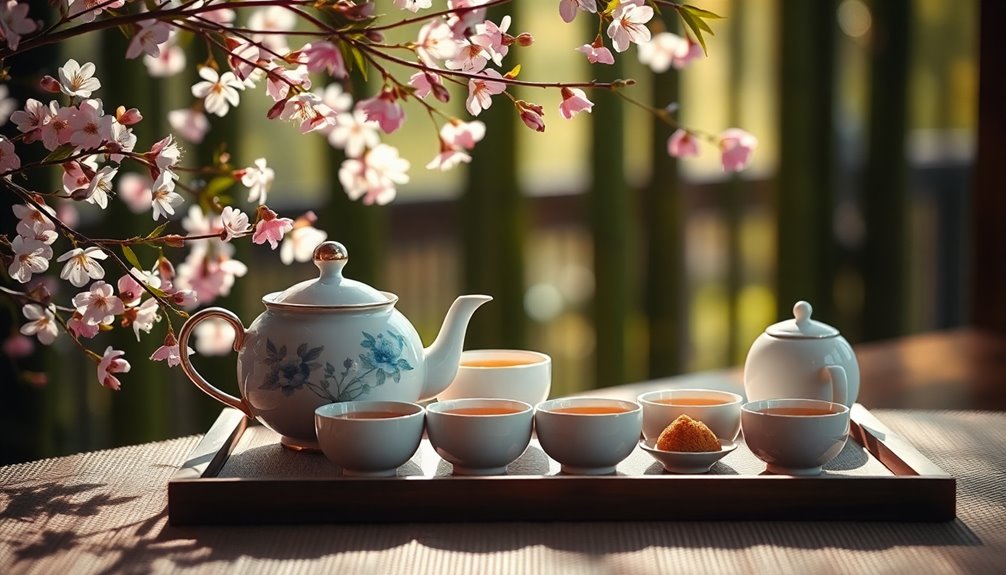
Tea serving rituals and customs provide a fascinating glimpse into the values and traditions of different cultures. For tea lovers, understanding these rituals enhances the experience of enjoying various types of tea.
In Japan, the tea serving ritual is steeped in mindfulness and aesthetics, showcasing the host's respect for guests through a beautifully choreographed ceremony. Meanwhile, British afternoon tea exudes sophistication, with a delightful spread of sandwiches, scones, and pastries that reflect social etiquette.
In China, the Gongfu tea serving method emphasizes precision in brewing and serving loose leaf tea, highlighting the significance of quality and the artistry involved in tea-making. Conversely, in Middle Eastern cultures, serving mint tea in small glasses symbolizes hospitality and warmth, often accompanied by sweets to welcome guests.
These tea serving rituals not only reflect cultural values but also influence social interactions.
Whether you're engaging in a communal tea drinking session or partaking in a formal ceremony, the way tea is served fosters connections and conversations, enriching the overall experience. Embracing these customs allows you to appreciate tea on a deeper level, transcending mere consumption to embody tradition and connection.
Serving Temperature Preferences
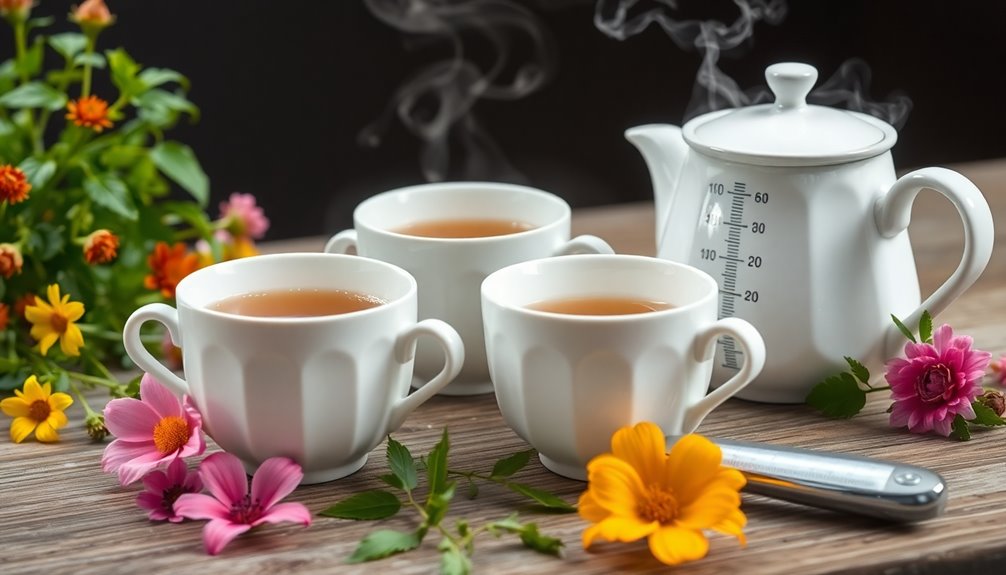
Temperature plays a crucial role in the enjoyment of tea, influencing flavor perception and overall experience. Your serving temperature preferences can reveal much about your personality.
If you enjoy your tea piping hot, you likely crave bold flavors and embrace intensity in life, reflecting an adventurous spirit. On the other hand, if you prefer your tea cooler, you might prioritize comfort and relaxation, showcasing your calm, easygoing nature.
For those who serve tea at precise temperatures, it signals an attention to detail and a methodical approach to life, suggesting you're organized and disciplined.
If you tend to switch up your tea temperature based on mood or occasion, you're probably flexible and adaptable, living life with an open mind and a willingness to go with the flow.
If iced tea or chilled servings are your tea of choice, it often indicates a sociable and fun-loving personality. You seek refreshment and enjoyment, especially in social settings. Additionally, those who prefer hot beverages may appreciate the optimal steeping time for enhancing flavor, further reflecting their interest in the nuances of tea preparation.
Ultimately, your serving temperature preferences are a delightful window into your character, highlighting how you approach both tea and life—whether you're embracing bold adventures or exploring new things with ease.
Tea Pairings With Food Choices
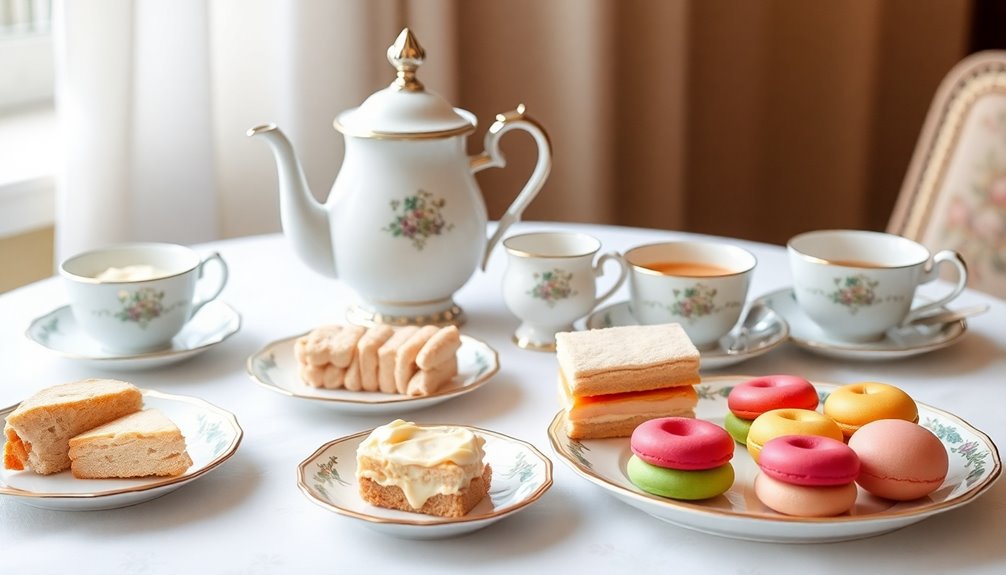
Finding the perfect tea pairing can elevate your dining experience and reveal your taste preferences.
If you enjoy Earl Grey tea with delicate pastries like shortbread, you likely appreciate classic sophistication and refined flavors. This choice showcases your knack for balancing tradition with elegance.
On the other hand, if you prefer green tea alongside light, fresh salads or seafood, it suggests you're health-conscious and value balance in your meals. This pairing reflects your commitment to wellness and a vibrant lifestyle.
Serving black tea with hearty breakfast dishes, such as eggs and toast, indicates a robust approach to your meals. You likely value energy and sustenance, embracing a traditional start to your day.
If you enjoy chai tea with spicy Indian dishes, it reveals a love for complex flavors and a spirited personality that thrives on cultural richness. This pairing shows your adventurous palate and willingness to explore diverse cuisines.
Lastly, pairing fruity herbal teas with desserts or fruit platters highlights your fun-loving, adaptable nature. You likely enjoy sweet and vibrant experiences, making your dining moments more exciting. Additionally, pairing your tea with flower teas can also enhance the flavors and health benefits of your meal.
Cultural Differences in Tea Etiquette
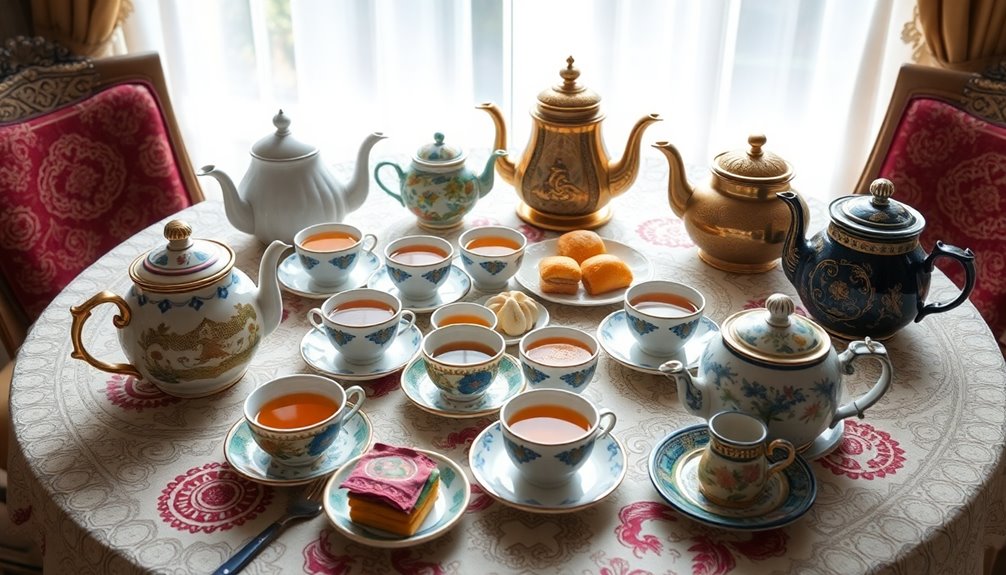
Across the globe, tea etiquette varies significantly, reflecting unique cultural values and traditions.
In British culture, you'd typically enjoy tea with milk and sugar, and proper etiquette dictates that milk is added after the tea. This practice embodies sophistication and tradition.
Meanwhile, in Japan, the tea ceremony emphasizes a meticulous process that showcases respect and harmony, with specific rituals for serving and receiving tea.
In India, chai represents hospitality and social interaction, often prepared with spices and milk and served in small cups. It highlights communal values, inviting conversation and connection.
In Middle Eastern cultures, serving mint tea is a gesture of welcome and generosity, reinforcing the importance of hospitality.
Conversely, in China, the Gongfu tea ceremony involves a detailed preparation that emphasizes artistry and appreciation for the tea's flavor and aroma. This practice reflects a deep cultural heritage and a reverence for the tea itself.
Each of these cultural differences in tea etiquette not only showcases personal preferences but also reveals how you connect with others, embodying the spirit of hospitality and the significance of the tea ceremony in fostering relationships.
Practical Applications
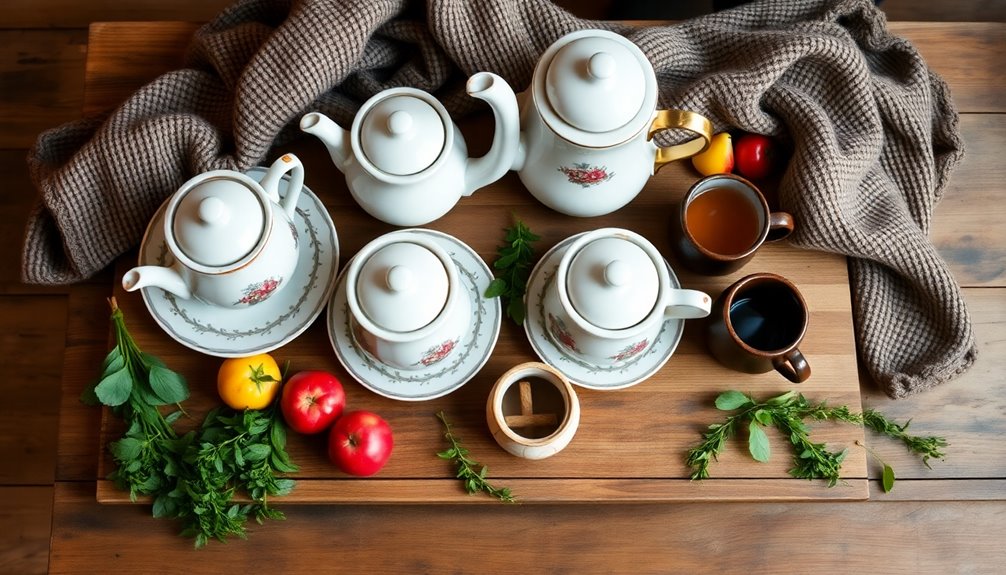
Tea culture isn't just about sipping; it's a reflection of your personality and lifestyle. If you gravitate toward loose leaf tea, you likely value quality and flavor, showing a more introverted and focused nature. Your choice of brewing methods, whether using a teapot or an infuser, hints at your patience and appreciation for life's complexities. Additionally, many loose leaf teas, such as green tea, are known for their health benefits, which may resonate with your health-conscious mindset. Furthermore, the calming properties of certain teas can enhance emotional well-being, making your tea experience even more profound. Eucalyptus oil, for example, is known for its decongestant effects, promoting easier breathing, which can be a comforting addition to your tea ritual.
On the other hand, if you prefer ready-made iced tea or bubble tea, you probably embody an outgoing, adventurous spirit. This choice signals a desire for convenience and social interaction.
When you serve tea, think about your style; pairing it with traditional accompaniments like shortbread for Earl Grey showcases a love for classic elegance and sophistication.
The presentation of tea also speaks volumes about you. Using unique teapots or elaborate serving styles reveals a creative and open-minded personality that appreciates beauty in everyday routines. Additionally, your choice of tea could also reflect your health-conscious mindset, as certain teas are known for their antioxidant properties that can combat oxidative stress and promote overall wellness.
Conclusion
In the end, how you serve tea reveals much about your personality and cultural influences. Whether you prefer a formal ceremony or a casual gathering, your choices reflect your values and tastes. Embracing different tea rituals can deepen your appreciation for this timeless beverage and connect you with others. So, next time you pour a cup, consider the message you're sending—your tea serving style is more than just a habit; it's a reflection of who you are.
-
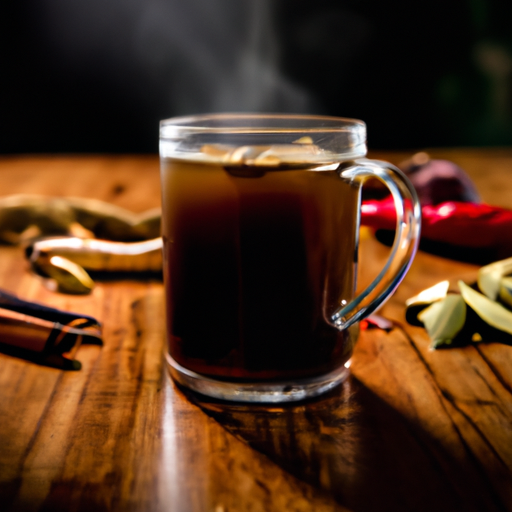
 Tea Brewing and Preparation5 days ago
Tea Brewing and Preparation5 days agoThe Ultimate Guide To Authentic Yogi Tea: A Spiced Immune-Boosting Ayurvedic Delight
-

 Turmeric Tea5 days ago
Turmeric Tea5 days agoIs Turmeric Good For Tooth Inflammation
-
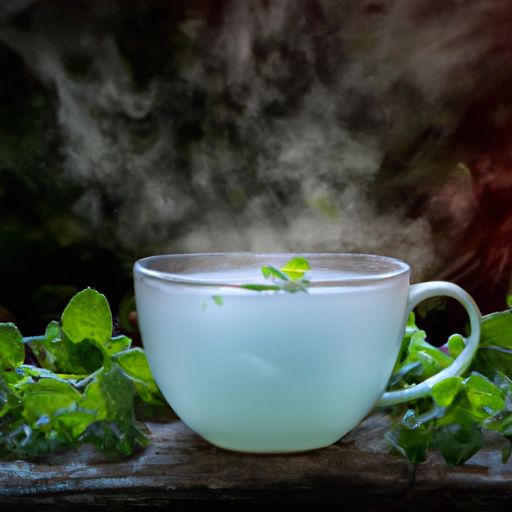
 Herbal Tea23 hours ago
Herbal Tea23 hours agoHow Does Peppermint Herbal Tea Help Clear Up A Cold
-
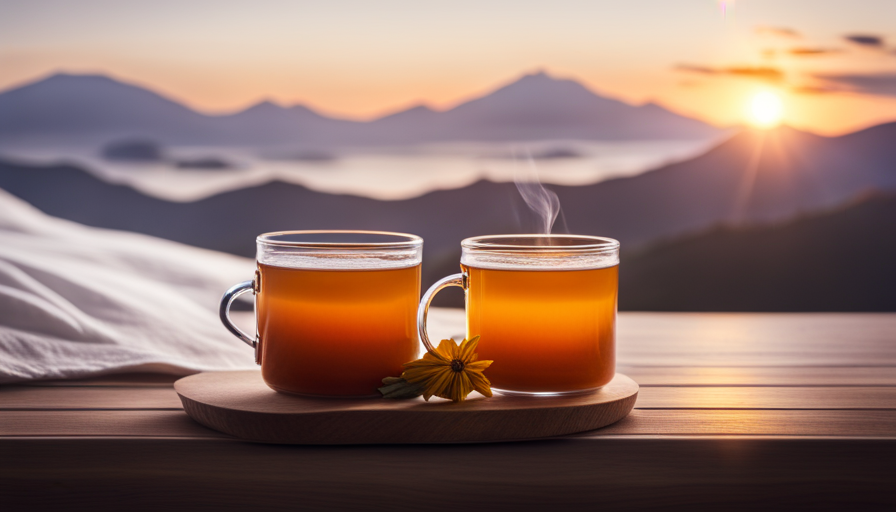
 Turmeric Tea5 days ago
Turmeric Tea5 days agoIs Turmeric Tea Good Before Bed
-

 Herbal Tea5 days ago
Herbal Tea5 days agoWhat Herbal Tea Is Good For Diverticulitis
-
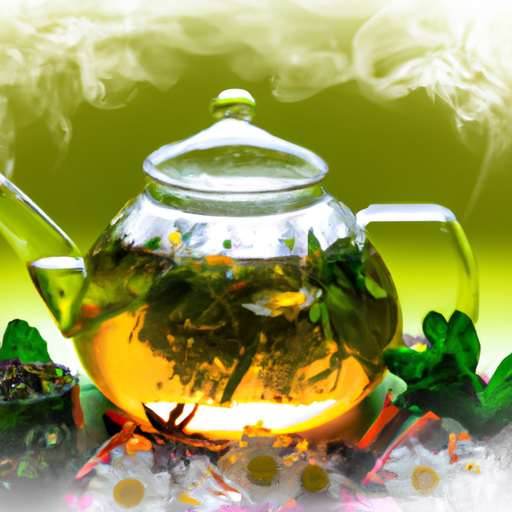
 Herbal Tea4 days ago
Herbal Tea4 days agoHow Much Potassium Is In Herbal Tea
-
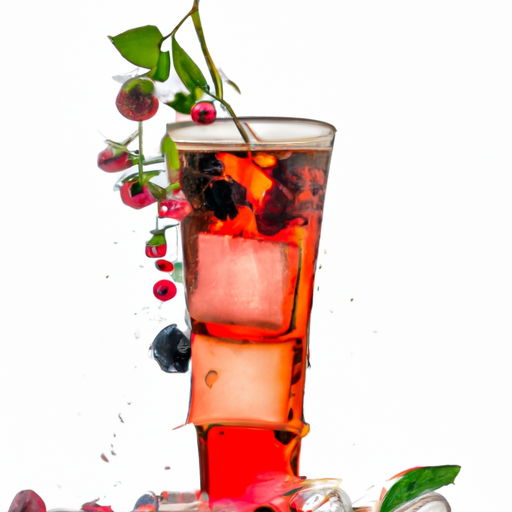
 Herbal Tea22 hours ago
Herbal Tea22 hours agoHow Much Caffeine Does Berry Berry Herbal Tea Have In Iced Form
-

 Herbal Tea22 hours ago
Herbal Tea22 hours agoHow Healthy Is Herbal Tea
